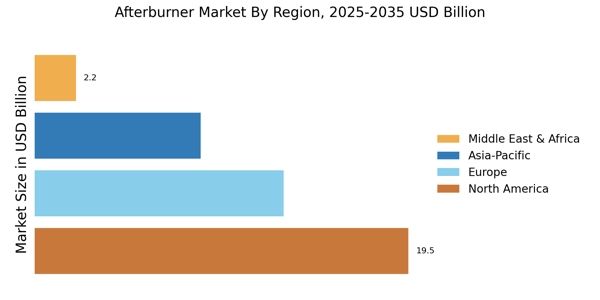Commercial Aviation Expansion
The Afterburner Market is also benefiting from the expansion of commercial aviation. With an increasing number of air travelers, airlines are seeking to enhance fuel efficiency and reduce operational costs. Afterburners, traditionally associated with military applications, are now being explored for commercial aircraft to improve performance during takeoff and climb phases. Recent statistics indicate that the commercial aviation sector is projected to grow at a compound annual growth rate of 4.2% over the next decade. This growth is likely to stimulate interest in afterburner technologies, as airlines aim to optimize their fleets for better performance and lower emissions. The Afterburner Market may see innovations that cater specifically to the commercial sector, potentially leading to hybrid systems that combine afterburner capabilities with eco-friendly technologies.
Rising Demand for Military Aircraft
The Afterburner Market is experiencing a notable increase in demand for military aircraft, driven by geopolitical tensions and defense modernization initiatives. Countries are investing heavily in upgrading their air forces, which often includes the integration of advanced afterburner technologies. According to recent data, military spending has seen a consistent rise, with an estimated increase of 3.5% annually over the past few years. This trend suggests that nations are prioritizing the enhancement of their aerial capabilities, thereby propelling the Afterburner Market forward. The need for superior performance in combat scenarios necessitates the use of afterburners, which provide the required thrust for supersonic speeds. As a result, manufacturers are likely to focus on developing more efficient and powerful afterburner systems to meet the evolving demands of military aviation.
Technological Innovations in Aerospace
Technological advancements are a key driver in the Afterburner Market, as innovations in materials and design are enhancing the performance and efficiency of afterburners. The aerospace sector is witnessing a surge in research and development activities aimed at creating lightweight, heat-resistant materials that can withstand extreme conditions. These innovations not only improve the thrust-to-weight ratio of aircraft but also contribute to fuel efficiency. Recent reports suggest that investments in aerospace R&D have increased by approximately 5% annually, indicating a strong commitment to advancing afterburner technologies. As manufacturers adopt cutting-edge technologies, the Afterburner Market is likely to evolve, offering more sophisticated solutions that meet the rigorous demands of modern aviation.
Growth in Space Exploration Initiatives
The Afterburner Market is poised for growth due to the increasing investments in space exploration initiatives. As private and governmental organizations embark on ambitious space missions, the demand for advanced propulsion systems, including afterburners, is likely to rise. The aerospace sector is witnessing a renaissance, with projected spending on space exploration expected to reach 500 billion dollars by 2030. This surge in funding is anticipated to drive innovation in afterburner technologies, as they play a crucial role in achieving the necessary thrust for launch vehicles. The Afterburner Market may see collaborations between aerospace companies and research institutions to develop next-generation afterburner systems tailored for space applications. This trend suggests a promising future for the industry, as it aligns with the broader goals of expanding human presence beyond Earth.
Increased Focus on Environmental Regulations
The Afterburner Market is facing a growing emphasis on environmental regulations, which is influencing the design and implementation of afterburner systems. As governments worldwide impose stricter emissions standards, manufacturers are compelled to innovate and develop afterburners that minimize environmental impact. This shift is prompting research into alternative fuels and cleaner combustion technologies that can be integrated into afterburner designs. The market may witness a transition towards more sustainable practices, as companies strive to comply with regulations while maintaining performance. Recent data indicates that the aerospace industry is expected to invest over 10 billion dollars in green technologies by 2030, which could significantly reshape the Afterburner Market. This focus on sustainability may lead to the emergence of new market players specializing in eco-friendly afterburner solutions.


















Leave a Comment